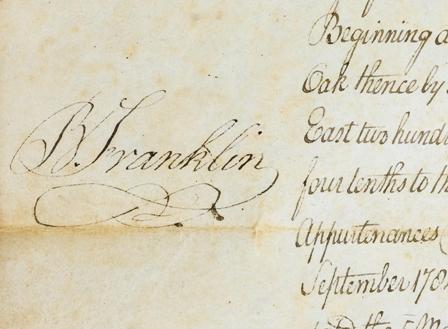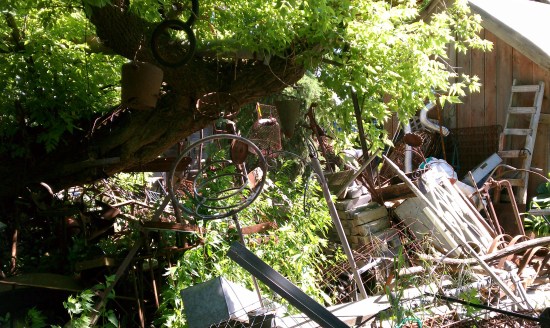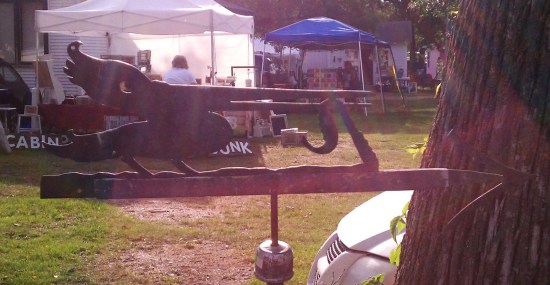Traditionally Thanksgiving involves giving thanks for family, friends, food and other blessings of a non-materialistic nature. I’ll be giving that little speech later today with family, don’t you worry about that; but this holiday I want to give special thanks from the bottom of my little collector heart.
 #1 “Thanks, ancestors, for settling here.” And by ‘settled’ I mean just that, setting up permanent houses. No offense to the more nomadic peoples, but I’m a collector; I need a place to store my stuff.
#1 “Thanks, ancestors, for settling here.” And by ‘settled’ I mean just that, setting up permanent houses. No offense to the more nomadic peoples, but I’m a collector; I need a place to store my stuff.
#2 “Thanks to all the people who don’t throw things out.” If it weren’t for you, I wouldn’t be able to find and adopt them.
#3 “Thanks, mom and dad, for instilling in me the love of collecting.” You taught me many joys of collecting… the rush of finding, the thrill of bidding victory, the coolness of displaying it all… But more than object ownership & the pursuit of it, you taught me what objects & collecting really is about.
Objects were never ‘just things’, but stories, lessons, and connections. You taught me that everything has/had a purpose. It was made to solve a problem, to express an emotion, or was in some way a part of a larger story. That story may be personal or part of the collective human story — sometimes, the story begins as one and ends as another. You didn’t just share your stories & knowledge, but did so with enthusiasm. And you encouraged us to share our own stories about what we learned, which in turn encouraged us to become lovers of learning.
These lessons in history, culture, art, form & function were all valuable — but none more valuable than the time spent with you. May I have the brains and patience to convert the passion for stuff into such gifts for my children.
#4 “Thanks, mom and dad, for teaching me how to collect.” The lessons here were many… Simple money management skills, for example, have served me well. But learning how to evaluate and establish the value of something has impacted my life the most.
Value is isn’t always what you think it is. It’s not just the price you pay for it, and it may be something no two people will ever agree upon either. Yet when it comes to monetary value, this can only be determined when people agree upon it. So if you don’t agree with the price suggested, negotiate.
 Lessons in negotiations taught me, even as a child, how to walk up to anyone with confidence and talk about anything — and how, when things weren’t going my way, to walk away politely without any upset. I’d done my best, but it just wasn’t going to work out this time. Everyone should learn that lesson.
Lessons in negotiations taught me, even as a child, how to walk up to anyone with confidence and talk about anything — and how, when things weren’t going my way, to walk away politely without any upset. I’d done my best, but it just wasn’t going to work out this time. Everyone should learn that lesson.
If & when you agree to a value and pay it, no matter what that amount is, you should treat that item with great care. The true value of that object is what made you want it in the first place, and, whatever price you paid, that was money you worked hard to earn. Dismissing these intrinsic values in the object does more than dishonor the object now entrusted to your care, but shows disrespect for yourself. It’s not that the guy with the bigger pile wins; but rather it’s the girl with the most integrity, who takes care of her things and show value for herself, who does.
#5 “Thanks, mom and dad, for teaching me what collecting is — and what it isn’t.“ Things are not more important than people, but objects can be a link to the people in our personal pasts and long-gone members in our family tree. As we hand traditions and stories down, the original objects themselves are the tangible proof of who walked and loved among us, as well as those who walked before us.
That said, no one should ever love an object so much that they are willing to sacrifice a family member or family peace over it. People first, things second.
 #6 “Thanks, teachers, for instructing me how to take an interest and turn it into an obsession.” Without the research skills you taught me, I never would have known how to sate my curiosity. Nor would I have learned that research may in fact only lead to more questions, more research, and that this too is a form of joy; the delight of discovery & the thrill of yet another new adventure are awesome things.
#6 “Thanks, teachers, for instructing me how to take an interest and turn it into an obsession.” Without the research skills you taught me, I never would have known how to sate my curiosity. Nor would I have learned that research may in fact only lead to more questions, more research, and that this too is a form of joy; the delight of discovery & the thrill of yet another new adventure are awesome things.
Of course, this would not have been possible if it weren’t for those who taught me not only to read but to love reading. (My book collection, especially thanks you.)
Ditto those who taught me to write. I may have cursed dangling participles, hated your red pen, but without you, my obsession & research would have no outlet.
#7 “Thanks to my dogs for not chewing on or otherwise destroying items and boxes left on the floor when we unload the van after a trip to an auction.” It means I have some time to make room for them all.
#8 “Thanks to my cat for reminding me that the boxes have sat there too long by sitting on top of the most visible box.” It reminds me the things in the boxes need better care, so I’d better find more safe and permanent storage for them.
#9 “Thanks to the guy who invented boxes.” It would truly suck if I didn’t have strong, stackable containers to carry things home and store them in.
 #10 “Thanks, museums & their staff, for housing & caring for what I cannot.” Everybody has limits — even museums. But without you, where would things, large and small, go and be preserved? Thanks for doing all that you can so that these objects and their stories will be there for others when they desire to see and learn about them.
#10 “Thanks, museums & their staff, for housing & caring for what I cannot.” Everybody has limits — even museums. But without you, where would things, large and small, go and be preserved? Thanks for doing all that you can so that these objects and their stories will be there for others when they desire to see and learn about them.
(And you make research that much easier too.)
#11 “Thanks, again, to all the people who don’t throw things out.” It bears repeating, because without you, what would I do?!
#12 “Thanks, hubby & kids, for not just putting up with me — but for collecting with me.” I love that we all go on collecting adventures together, and that we share our finds, discoveries, and stories. I love that you listen to mine (and review games with me on occasion), of course, but it’s not every mother, every wife, who is lucky enough to be the goal of a footrace as every one rushes to tell her what they found, how they found it, and why it’s so special.
 Every time we talk about our things, asking questions — and listening to the answers, I think how lucky I am to have a close family comprised of such inquisitive & interesting people. It’s a privilege to collect with you.
Every time we talk about our things, asking questions — and listening to the answers, I think how lucky I am to have a close family comprised of such inquisitive & interesting people. It’s a privilege to collect with you.
#13 “Thanks, makers of the Internet, for creating a new world.” Without the Internet, my collecting world would be so much smaller… Smaller in terms of finding, buying, selling, researching, and meeting other folks as obsessed as I. It’s nifty to know that there are other nuts like me — folks even nuttier than me — ‘out there somewhere’; but it’s hard to put into words just how keen it is to meet these fellow-nuts, see their glorious stuff, and learn their stories.
#14 “A special thanks to you, dear reader.” Your reading, comments, and emails are proof that I’m not alone in my obsession… The objects of our affections may differ (delightfully!), but we are all a part of the same thing. It’s a privilege to collect with you, too.












































































 Two designs were made of the Stella: a “flowing hair” version, like the one in the Stack’s Bowers auction, and the “coiled hair” design, which is rarer. The “flowing hair” Stella was designed by mint artist Charles E. Barber; the “coiled” by George T. Morgan. Both designs were quite similar, and both shared the same reverse. The reverse design is what gives the coin its name: the center of the coin is filled with a large star — a “stella” — thus giving the coin a casual name, like the “eagle” gold coins which came as portions of $10. Being worth $4 means it could be divided in fourths into smaller denominations, like a dollar and the $10 gold eagle were.
Two designs were made of the Stella: a “flowing hair” version, like the one in the Stack’s Bowers auction, and the “coiled hair” design, which is rarer. The “flowing hair” Stella was designed by mint artist Charles E. Barber; the “coiled” by George T. Morgan. Both designs were quite similar, and both shared the same reverse. The reverse design is what gives the coin its name: the center of the coin is filled with a large star — a “stella” — thus giving the coin a casual name, like the “eagle” gold coins which came as portions of $10. Being worth $4 means it could be divided in fourths into smaller denominations, like a dollar and the $10 gold eagle were.